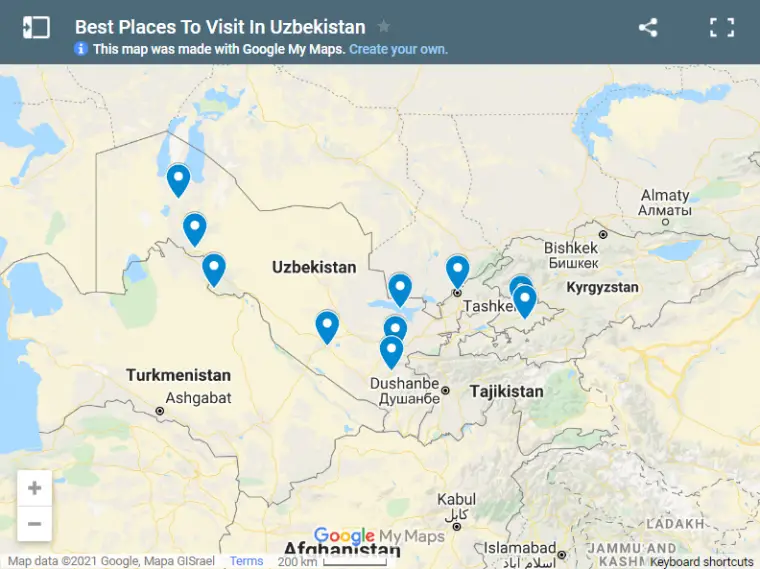Thinking about visiting Uzbekistan? Wondering what to do in Uzbekistan? What are the best places to visit in Uzbekistan? What are the top things to do in Uzbekistan?
You are in the right place!
Uzbekistan is a fabulous country to visit. In fact, before I started thinking about visiting Uzbekistan, I had no idea just how many awesome Uzbekistan places to visit there are. I was blown away while still in the planning phase!


After reading this article of all of our top picks of the best places to visit Uzbekistan, I am sure you will be equally blown away. There are many interesting historical places in Uzbekistan and many places in Uzbekistan where you can experience more of the interesting cultures you will find here.
The best part is that even though tourism in Uzebkeistan is growing, the numbers of tourists are still not high – which means you can enjoy these famous places in Uzbekistan without being overrun by others. In fact, sometimes it can feel like you are the only tourist there. The prices are also very reasonable and travelling easy. All in all, Uzebkeistan is a great place to visit!
And whether you are interested in natural Uzbekistan tourist places, historical places of Uzbekistan or getting up close to the locals, there are many opportunities in the following top places to see in Uzbekistan for whatever it is you want to experience on your trip.
Top 9 Best Places To Visit In Uzbekistan
Samarkand
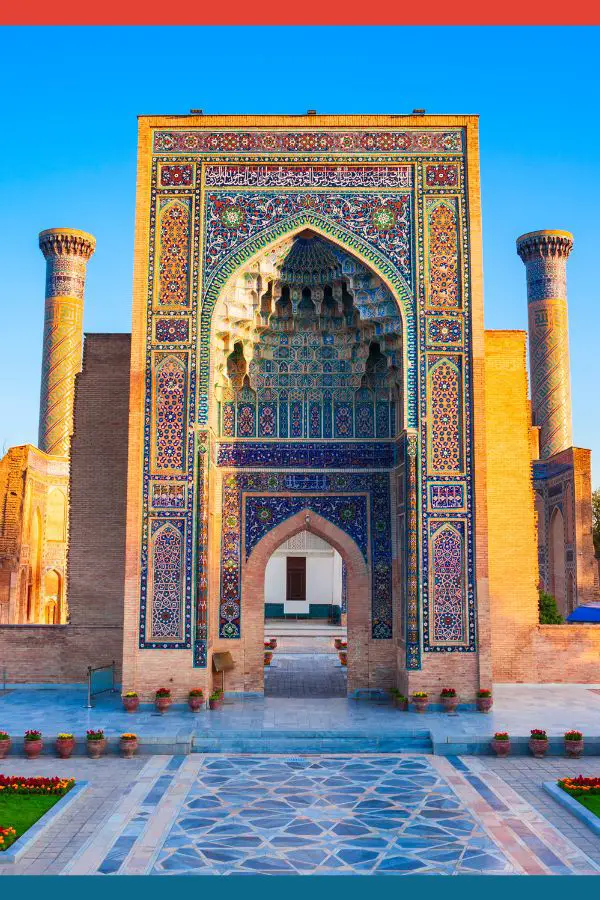
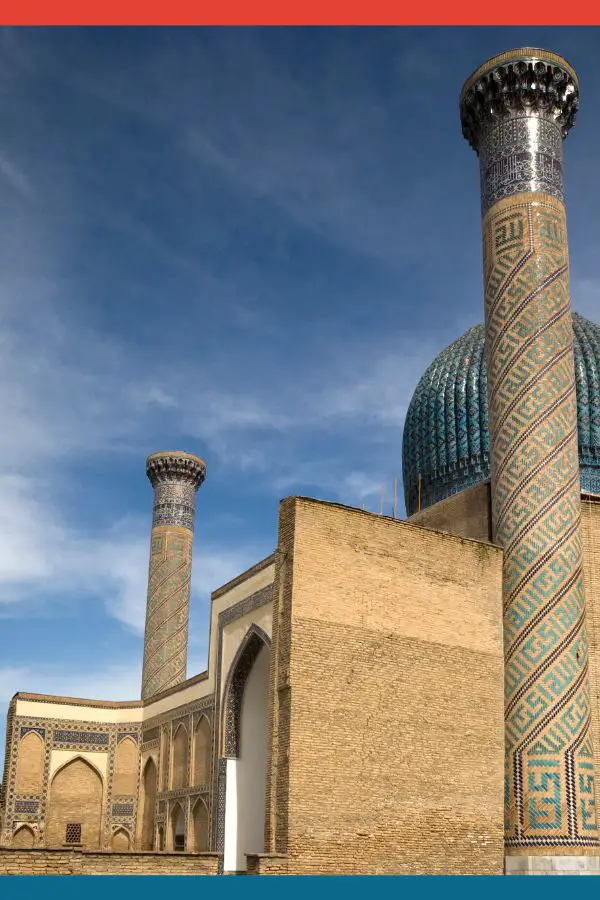
The country’s second largest city, sandwiched between Tashkent and Bukhara, Samarkand should be on your list of things to see in Uzbekistan. An iconic crossroads between East and West on the Silk Road and the fabled city from 1001 Nights, Samarkand was added to the UNESCO World Heritage list in 2001.
Today, the city is an urban sprawl of modern buildings with hidden time-worn ruins – on par with Rome or Athens – that showcase influences from previous rulers and magnificent Islamic architecture.
An impressive 14th century public square built in the heart of the city by the Timurid Empire, the Registan is regularly top in listings for Uzbekistan top attractions. Meaning “sandy place” in Persian, the Registan was a place for travelers to trade their wares, hear Royal proclamations, watch parades and executions.
Framed by three uniquely designed madrasahs (14th and 17th century Islamic schools), they form what is noted as one of the world’s most dramatic grand squares. The blue domes, tall minarets, patterned mosaics, and bright tiles have influenced far across the world’s cities, from Isfahan in Iran to Russia’s St Petersburg.
Visit early before the crowds arrive and stroll amongst the majestic arches in the early morning sun or return at night to catch a 3D light show that illuminates the square in a colorful glow.
Explore Shah-i-Zinda, meaning “The Living King”, with its 40 buildings protecting 9-14th century mausoleums – including the legend that Kusam ibn Abbas (the cousin of the prophet of Muhammed) is buried here.
Move on to visit Gur Emir Mausoleum, the family vault of Amir Timur – a Turco-Mongol conqueror from the 14th century and regarded as one of history’s greatest military leaders. Built in 1404, and supposedly the blueprint for Agra’s Taj Mahal, observe the richly decorated entrance with carved bricks and various mosaics, and the ornate carved headstones.
Lists of top Uzbekistan sightseeing places always include the Bibi-Khanym Mosque and Mausoleum. In the 15th Century, this beautiful cathedral mosque was one of the largest and most magnificent in the Islamic world. Named after Amir Timur’s wife, the mesmerizing blue dome is a sight to behold!
Take a drive out to the Afrasiyab Settlement & Museum, located in the high hills, and wander these ancient ruins of the pre-Mongolian period. You will also find the Prophet Daniel Mausoleum in the Afrasiyab suburbs, a 5-domed building that stretches along a steep hill, guarding a spectacular 18-metre long sarcophagus.
Spend a second day discovering local culture and meeting locals. Stroll through the Alisher Navoi Central Recreation Park before dropping into a local chaykhana (teahouse) for Uzbek cuisine of stews, dumplings, or snack on Samarkand Non (a giant bagel).
Spend a few hours at the colourful Siyob Bazaar, adjacent to the Bibi-Khanym Mosque, and taste the local fudge-like sweet, halva. Visit Hudjum, a traditional silk carpet factory showcasing hand-made rugs by Uzbek female masters, or drop by the Hovrenko Wine Factory for a taste of locally made sweet wines. End the day at a Hammam for sauna followed by an intense traditional massage.
Getting to Samarkand: Fly into Samarkand International Airport or take a high speed train from Tashkent in little over 2 hours, passing through stunning landscapes and mountain ranges.
Top attraction to visit: Registan
Bukhara
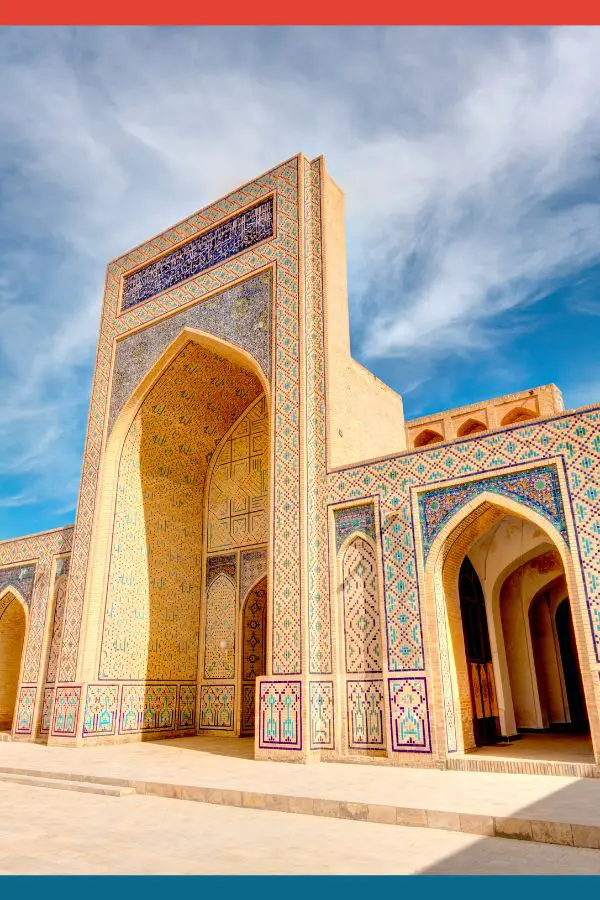

A holy city of the Muslim world and once the capital of the Samanid Empire, it’s no surprise UNESCO listed the spectacular historical centre a World Heritage Site. Filled with Uzbekistan famous places, including over 140 architectural monuments – mosques, shrines, madrasahs, and a massive royal fortress – some built 2300 years ago.
Once known as Madinat Al Tujjar, The City of Merchants, Bukhara is rich with history stretching back to the 15-day siege by Genghis Khan and most recently the siege by the Red Army in the Russian Civil War. The city has long served as a centre of trade, scholarship, culture, and religion, with traders travelling from India to Venice along the Silk Road. These days many of the merchant houses have been converted into wonderful B&Bs.
The Bukhara symbol is the 47-metre-high Kalyan Minaret, built in 1127 by the Turkic Karakhanid dynasty and found in the Po-i-Kalyan Complex. Decorated with terracotta bricks, giving the structure its distinctive stripes, it was once the highest minaret in Central Asia and used as a lighthouse to show the way for trade caravans and pilgrims. Within the same complex, visit the Kalan Mosque, completed in 1514, and able to accommodate up to 12,000 people.
Equally spectacular is The Ark Fortress, a fortified castle that has been a symbol of power for millennia. This enormous white washed military fortress housed many of the kingdom’s royals and in the Samanid era housed a large library with rare books from all over the world. Visit the onsite museums to learn more about the dramatic history of the Ark, one of the must see places in Uzbekistan.
Across from the Ark check out the intricate ceiling and richly carved wooden pillars of Bolo-Hauz Mosque, a beautiful building also not to be missed.
Uzbekistan’s cities all have amazing bazaars, but none take you back in time to the old Silk Road as those of Bukhara. Four interlinked trading domes still operate today, selling gold, embroidery products, carved furniture, silk and spices. Look out for the famous “Bukhara carpets”, historically woven by nomadic or village Turkomans.
Unlike Samarkand, Bukhara’s Old Town is an authentic maze of narrow paved side streets, magnificent structures decorated with intricate ornaments, blue domes, minarets and leafy plazas. And, despite being heavily restored, the Old Town has retained its authentic feel.
Take a break from the historical sites and visit Lyab-i-Haus, a leafy oasis in the heart of Old Bukhara, built around a small pond lined with quaint cafes that back onto mosaic covered madrassas and monuments. Relax at a tea house and select from specialities such as saffron and ginger tea, or coffee with cardamom.
Alternatively, head to Samanid Park, another nice break from the hectic city, which is also home to the Samanid Mausoleum with the remains of Ismail Samani who ruled Bukhara in the 9th century.
In the evening, dine at the Sukhov Water Tower’s second floor restaurant and admire splendid views of the Ark of Bukhara.
The next day learn how wealthy merchants used to live by visiting the 19th century Khodjaev House Museum or visit the Bukhara Photo Gallery. Take a trip outside the city to the 20th century palace Sitorai Mokhi-Khosa (as beautiful as the moon, as the stars). Home of the last Emir, the palace was inspired by Russia’s great imperial palaces and has lavishly decorated halls, plus a great collection of Chinese porcelain and Venetian glass.
Finally, visit the 500-year-old famous Hammam Borzi Kord for a relaxing treatment – a good end to a busy few days overflowing with activities in Uzbekistan.
Getting to Bukhara: Fly into Bukhara International Airport or arrive by bus or train. Bukhara is the largest transport hub after Tashkent in Uzbekistan, with roads and railroad links to all major domestic cities.
Top attraction to visit: The Ark of Bukhara
Tashkent
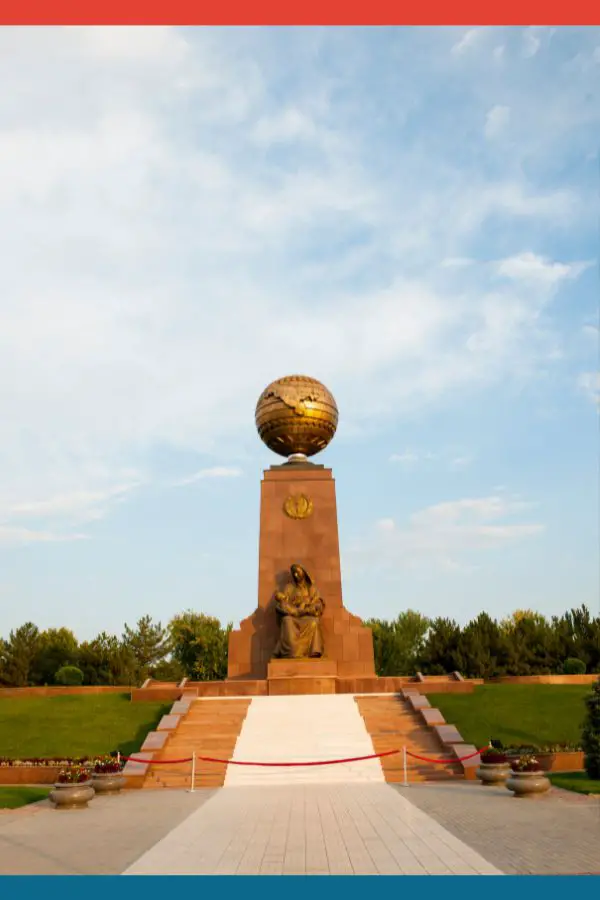

Uzbekistan’s capital city is known for its wide tree-lined streets, numerous fountains, and pleasant parks. Though most of the ancient city was destroyed in the 1917 revolution and further in the 1966 earthquake, the city has a wealth of museums and Soviet-era monuments, alongside plenty of modern restaurants and buildings.
If starting your Central Asia adventures in Tashkent head to the Chorsu Market, centuries-old and housed in a Soviet-constructed blue-domed building. It offers glimpses of the ethnic and cultural blend Tashkent is famous for. Make sure you try one of the hundred types of kurut – a local snack of dried cheese balls. And, if you enjoy shopping, there are up to 20 bazazrs in Tashkent to keep you busy!
With many places to visit in Tashkent Uzbekistan there is perhaps nowhere better to start than at the Hazrat Imam Complex. Mosques, with turquoise domes similar to those in Samarkand, wait to be discovered, along with the Muyi Mubarak Library said to contain the world’s oldest Quran and a hair from Prophet Mohammad.
Stroll on to the Kulkedash Madrassa, an old Islamic school dating back to the 16th century, used in later years as a fortress and a place for public executions.
Time for lunch? Buy a token and take a ride on the stunning Tashkent Metro. Built deep in the ground during the Soviet’s reign, each station is elaborately decorated with marble, mosaics and massive candelabras, making this one of the famous things in Uzbekistan.
Jump off at the Central Asian Plov Center, one of the best places in Uzbekistan to taste plov. Fried rice is cooked in lamb fat, with raisins, carrots and different types of meat. This local delicacy is usually cooked in massive pans which can feed hundreds of people!
Back on the Metro to Timur Square, look out for the impressive Hotel Uzbekistan – a hulking classic Soviet-style hotel. Built in the form of an open book, you’ll want to capture this on camera before heading to the Amir Timur Museum, dedicated to the Mongol warlord. Admire The Palace of International Forums, considered the country’s most spectacular palace, and pass fountains and statues, as you walk through to Independence Square.
End your day with a visit to the Uzbekistan State Museum of Applied Arts to discover the local industries of silk weaving and ceramics, or visit the State Museum of History of Uzbekistan.
In the evening, drop by the Tashkent TV Tower – the tallest building in Uzbekistan – and take in the stunning city views from the observation deck.
If you have time, extend your stay with a visit to the Charvak Reservoir or drive up into the surrounding Chimgan Mountains.
Getting to Tashkent: Fly into Tashkent International Airport, connecting the city to Asia, Europe and North America.
Top attraction to visit: Amir Timur Museum
Khiva
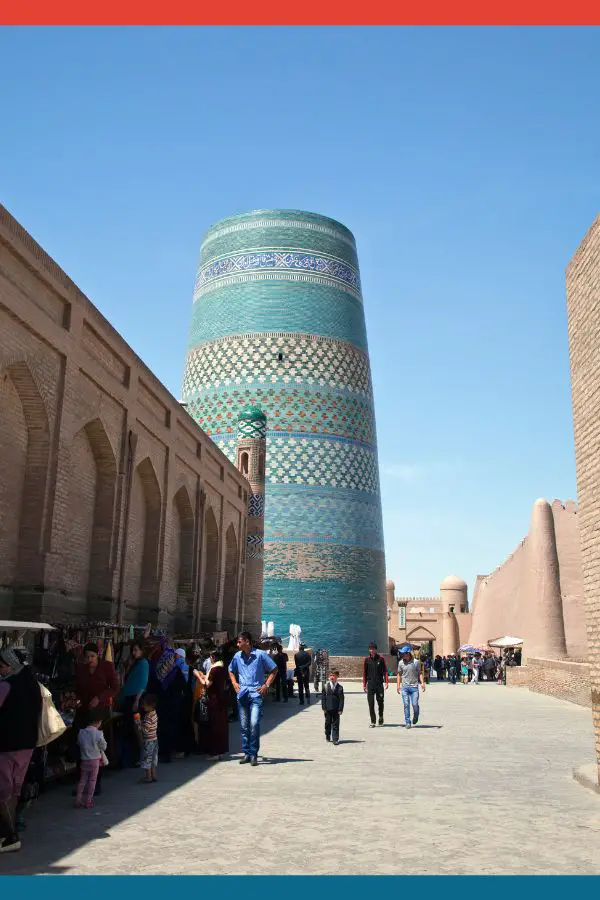
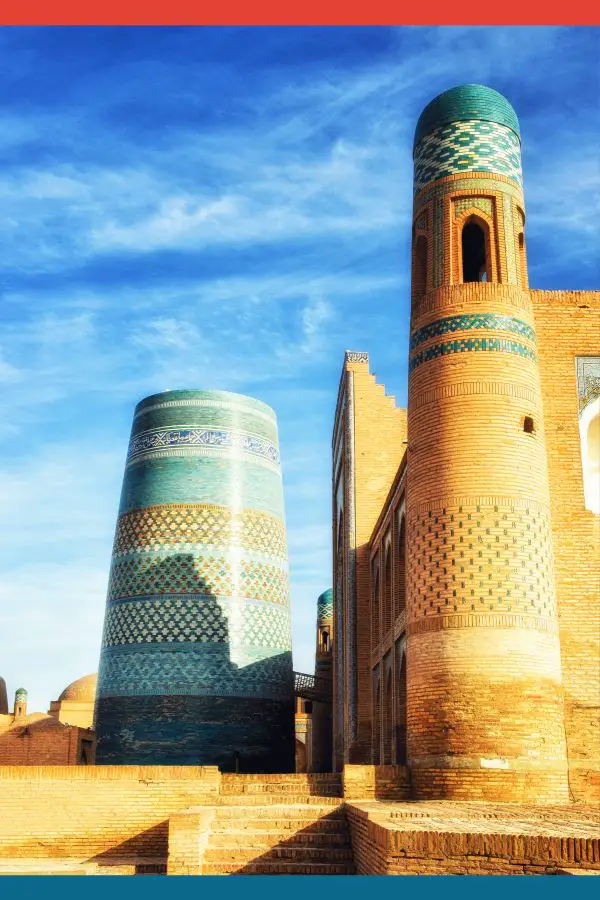
Archaeologists say that Khiva was founded in the 5th or 4th centuries BC, and later flourished as a trading post on the Silk Road. By the 19th century the city was divided into the Inner (Itchan Kala) and Outer (Dishan Kala) cities, separated by a 10-metre perfectly preserved high wall.
Wandering through the UNESCO listed old town, it is not hard to imagine camel caravans loaded with spices and silks or frenetic bazaars filled with merchants, passing stunning mosques and madrasas. Once synonymous with slave trade and barbarism, Khiva is now closer to a living museum.
Peppered with over 50 historic monuments and 250 old houses from the 18th and 19th centuries, a historian’s idea of heaven, Khiva is one of the most beautiful places in Uzbekistan. Within the mudbrick walls fine examples of Muslim architecture, spanning over two millennia, wait to be discovered showcasing some of the best sightseeing places in Uzbekistan.
Visit the Djuma Mosque, perhaps the most outstanding structure with over 200 columns in the main chamber, or spend time exploring the two magnificent palaces built at the beginning of the 19th century by Alla-Kulli-Khan. Another contender for standout beauty is the small Pahlavon Mahmud Mausoleum – still an active place of worship and pilgrimage spot for local Uzbekistanis.
From the long list of Khiva Uzbekistan places to see, the Kalta Minor Minaret, rather recently constructed in 1851, is one for the energetic. Climb the steps of this 45-metres Islam Hoja minaret for beautiful city views.
One of the more interesting places in Uzbekistan, the old town’s wall has four main gates. Pay to enter through the Western Gate – giving you entrance to most of the museums and buildings found inside – and you’ll find the Kuhna Ark.
Home of past Khiva rulers, this 12th century fortress and residence offers a peek into the life of the Khans – their harem, mint, stables, arsenal, throne-room and pretty Summer Mosque. Pay extra to climb up to the watchtower for extraordinary city views.
Getting to Khiva: Fly into Urgench International Airport and share a 30 minutes taxi to Khiva. Alternatively reach Urgench by the night train from Tashkent or standard train from Bukhara. A train station in Khiva is under development.
Top attraction to visit: Kalta Minaret
Shahrisabz
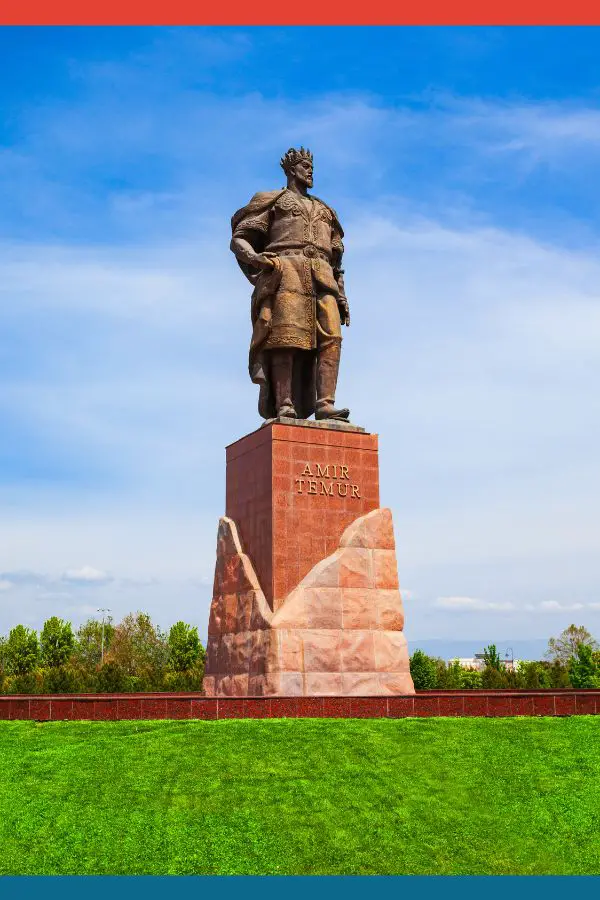
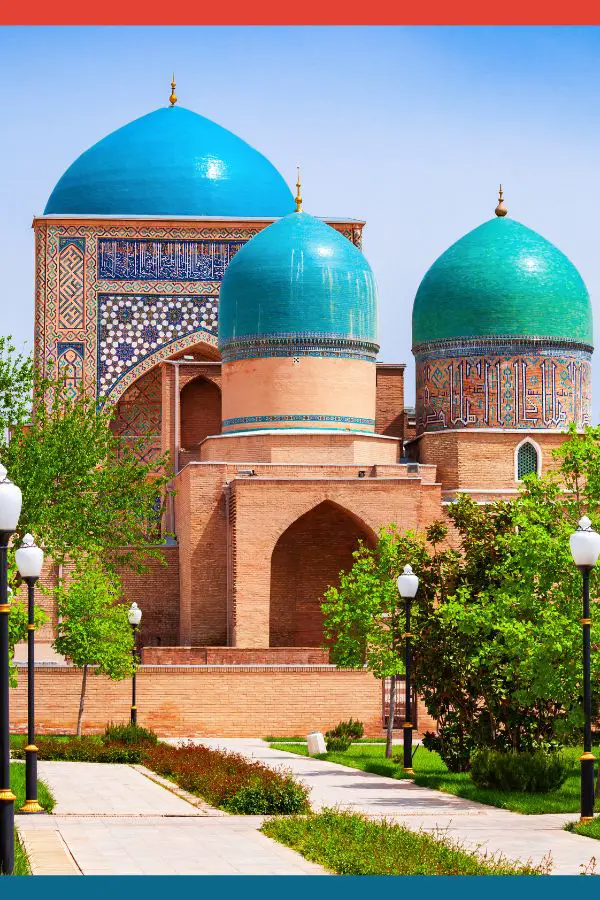
Famed as the birthplace of the 14th century conqueror and national hero, Emperor Timur, Shahrisabz (green city) is one of the most ancient cities in Central Asia. A small, traditional Uzbek town in Kashkadarya province, it was listed in 2000 as a UNESCO World Heritage Site and is a popular day trip from Samarkand.
Timur’s Summer Palace, Ak-Saray Palace, (white, light, magnificent palace) was a white-marbled lavish palace back in the 1400’s, taking almost 25 years to complete and almost 50,000 slaves. Unfortunately not much remains, but you can walk through the central area with the massive walls towering over you.
Pass by the Amir Timur statue and continue through a park until on your left you’ll find the Medrese Chubin, home to the Amir Timur Museum. Not the greatest selection of artifacts or information, you can choose to skip this if you have already visited the museum in Tashkent.
From the park you’ll see the large blue dome of the Dorut Tilovat Complex, housing the Kok Gumbaz Mosque and two mausoleums.
Further on is your final spot for the day, the Dor-Us-Siyadat Complex which houses the crypt that was originally meant for Amir himself, but is the resting place of his beloved grandson who died unexpectedly.
Not as impressive as Samarkand, Shahrisabz is worth a trip out for the dramatic scenery along the route.
Getting to Shahrisabz: Located 55 miles south of Samarkand, it is best visited as a day trip. Taxi drivers take you the 2-hour scenic drive, passing through small villages and roadside markets with towering mountains dominating the view. Your driver will wait whilst you spend approx 2-hours discovering the town, before returning to Samarkand.
Top attraction to visit: Ak-Saray Palace
Nukus
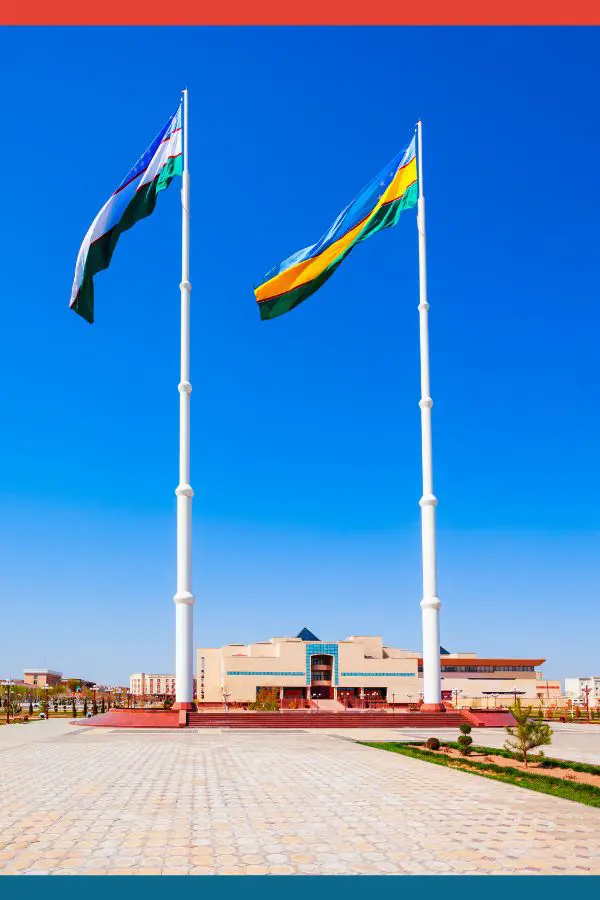
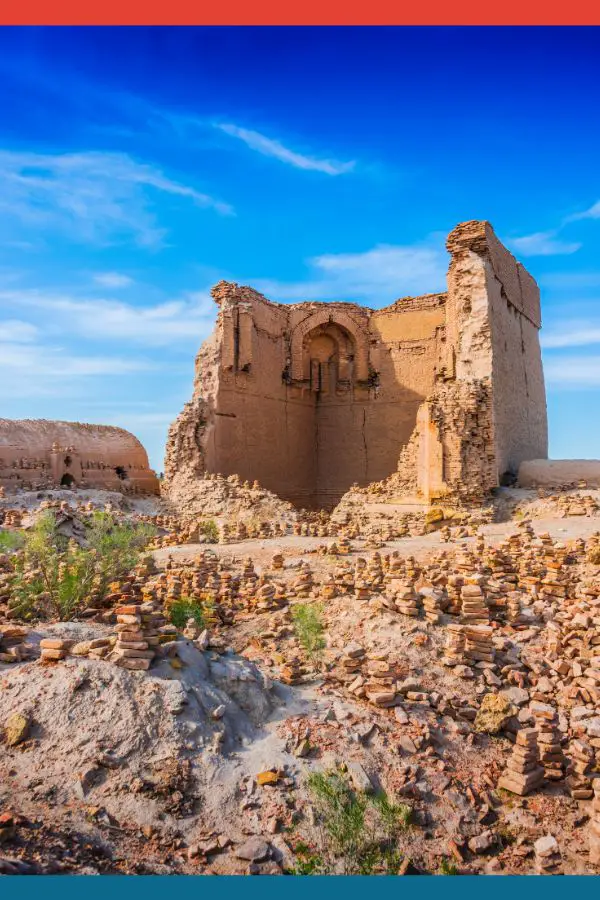
Nukus grew from a small settlement in 1932 to a large, modern Soviet city with broad avenues and large public buildings, surrounded by a landscape of desert dry scrub. However, recent modernization is slowly destroying its Soviet past, though it has a rather desolate feel as most new buildings remain empty and has yet to join most traveler’s lists of sightseeing places of Uzbekistan.
Visit Nukus for its remoteness and isolation, but you will still find a few interesting things to do that make this a worthwhile destination in your Uzbekistan itinerary.
Within the city visit the world-class Igor Savitsky Art Museum – the lost Louvre of Uzbekistan – housing an unusual collection of artifacts recovered from archaeological digs, traditional jewelry, costumes and musical instruments. The museum is most noted for its rare collection of modern Russian and Uzbek art from 1918-35, making it one of the most unique places of interest in Uzbekistan.
Take lunch at the typical central Asian bazaar where you can try local delicacies such as beshbarmak (thin boiled dough served with a meaty broth) and kymyz (fermented horse milk).
One of the stranger Uzbekistan things to see, is the Mizdakhan Necropolis. Located just outside of Nukus it’s still an active place of worship where people bury their dead, but amongst the new tombs are hundreds of ancient tombs offering an insight into the mixed ethnic history of the region.
Most tourists use Nukus as the gateway to the Aral Sea – with daily buses departing morning and returning late afternoon – and the desert of Karakalpakstan, with its famed ancient fortresses and mausoleums.
Getting to Nukus: Fly into Nukus Airport, with domestic flights from Tashkent (2 hours) and internationally from Moscow. Train connection from Taskkent (approx 20 hours).
Top attraction to visit: Igor Savitsky Art Museum
Fergana Valley
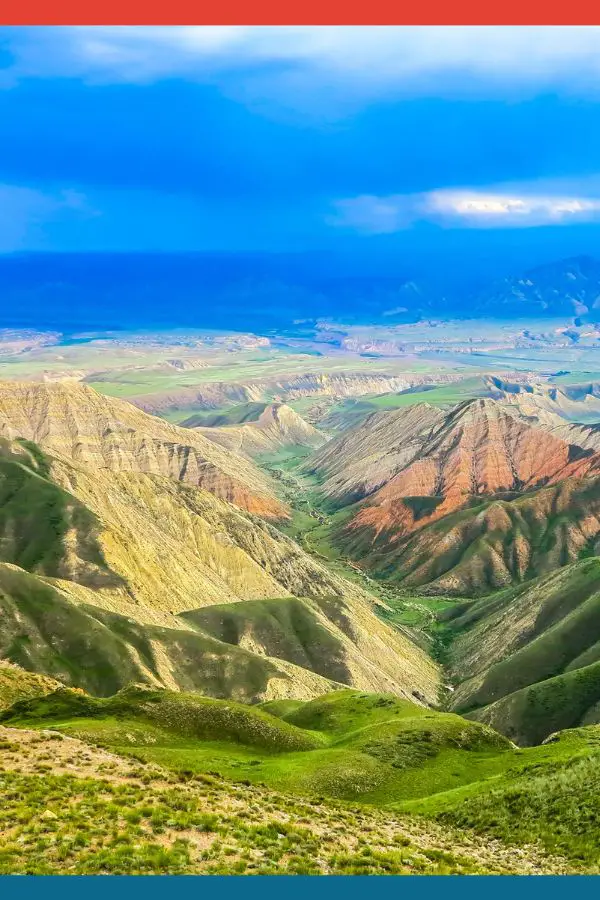
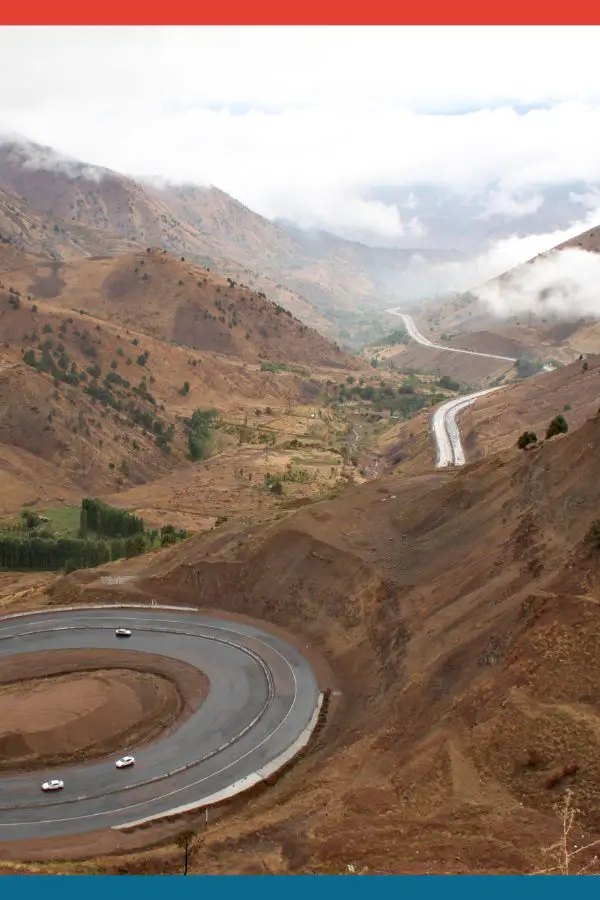
Stretching across Central Asia, the Fergana Valley formed a crucial part of the Silk Road. With the Tien-Shan mountains to the North and the Gissar-Allai to the South, it is an area of stunning natural beauty and a major source of food. Despite the relatively dry climate, the valley is green and fertile plains are fed by the Rivers Naryn and Kara Darya. Wheat, cotton, rice, vegetables and fruit are farmed across the 22,000 sq km of flat plains.
Historically, the location for many territorial battles, the area reaches across eastern Uzbekistan, through Kyrgyzstan and to Tajikistan. Spend time here to understand authentic Uzbekistan and learn about the local culture, ethnic diversity, historical conflicts, and environmental issues. Hang with locals, stroll through parks, and stop at the numerous local cafes to meet, what many say, are the nicest people in Uzbekistan.
Base yourself at one of the main cities and take day trips to explore the region and visit, what we feel, are some of the most beautiful places of Uzbekistan. We recommend staying at Fergana City or Margilan.
Fergana City is the capital of the Fergana Valley and home to excellent restaurants, and a transport hub with frequent connections to Margilan, Rishton, Andijon and Kokand. A relatively new town with a large Russian population, there is not too much to see except for the central park.
Twenty minutes from Fergana, is Margilan. A traditional town with small back alleys showcasing every-day life, bursting with character. Visit the Yodgorlik Silk Factory to see the painstaking processes involved in producing the beautiful handmade material, and the colourful Kumtepa Bazaar. A handful of madrassas and mosques are also open to visitors.
For more than 800 years Rishton has been the centre of pottery in Uzbekistan, with the local red clay so pure it needs no additives. Ceramics are decorated with distinctive, naturally produced, blue and green shades. Search out the Usmanov Ceramic Workshop for a free tour by one of the oldest masters.
Another standout city, and at one time as important as Bukhara, Kokand has many of the Uzbekistan best places to visit including the beautiful Khudayar Khan Palace, built in the 19th century boasting seven courtyards and 113 rooms, and the Modari Khan Mausoleum. Home of the Norbutabiy Mosque and the Juma Mosque – a beautiful 19th century mosque noted for its colourful minaret supported by columns made from Indian Redwood trees.
In Fergana Valley, Uzbekistan, beautiful places in the south of the Valley await your discovery. Travel to the Blue Lake of Shahimardan, in the hills of the Allai Mountains. Take the cable car from the centre of Shahimardan up to Kurbal Kul and admire a photogenic blue alpine lake. Set peacefully amidst the mountain peaks this is one of the top places to visit in Uzbekistan in winter.
The best way to get around the Valley is by shared taxi. Fergana to Margilan is 30 minutes, Rishton 1 hour, Kokand 2 hours, Andijon 1.5 hours.
Getting to Fergana Valley: Modern train from Tashkent, approx 3-4 hours or fly into Fergana International Airport.
Top attraction to visit: Margilan
Moynaq/Muynak

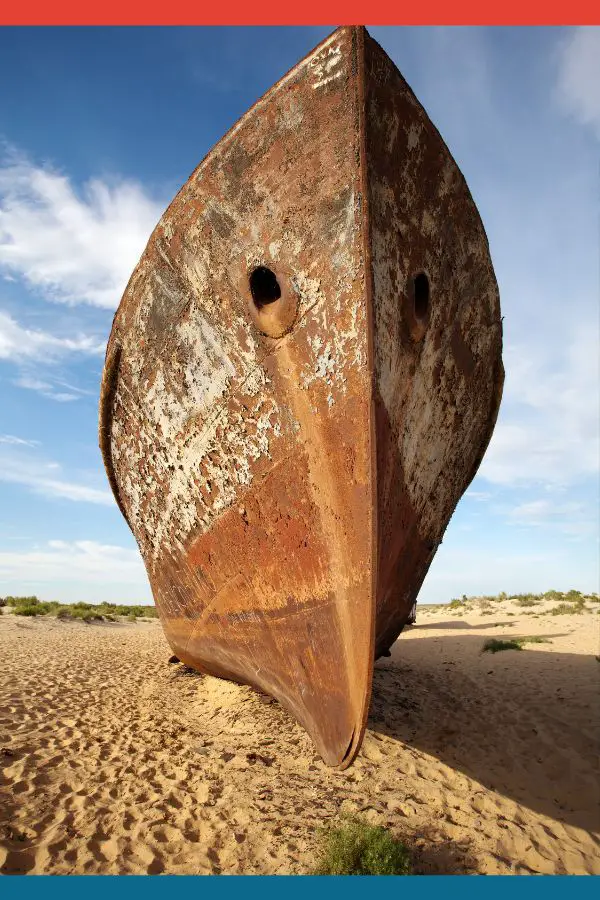
The Aral Sea was once the fourth largest lake in the world. But in the 1960s the Soviet Union undertook a major water project diverting two main rivers to arid plains and away from the Aral Sea, devastating the region. This ecological disaster means that today only 10% of the Aral Sea remains and salinity is so high that almost all marine life has perished.
As the Aral Sea dried up, fisheries and communities that depended on them collapsed. The former shores and the desert ex-seabed are now littered with rusting hulks of boats which can be best viewed at Moynaq, once a thriving harbour town and now strangely one of the top Uzbekistan tourist attractions.
Moynaq has seen some recent development, giving the town a new city centre but there is little to do outside of visiting the ship cemetery and a small museum. However, with the 3-hour road travel from Nukus, travelers often choose to stay a night.
Visit the ship cemetery at dusk to grab some great sunset silhouette photos.
Beyond the boats is the vast empty desert waiting to be discovered. From within Moynaq, arrange a 4-wheel drive to take you to Sudochie Lake. Once a freshwater lake connected to the Aral Sea, it is a smaller but still thriving lake home to over 200 bird species, including pink flamingos. Off the route for travelers, we rate this as one of the don’t-miss places to go in Uzbekistan.
Up for a longer drive? Take a 3-4 hour drive by 4-wheel vehicle from Moynaq to the current shore of the Aral Sea, approx 150km away.
Getting to Moynaq: 3 hour bus from Nukus.
Top attraction to visit: Ship Cemetery
Aydarkul Lake
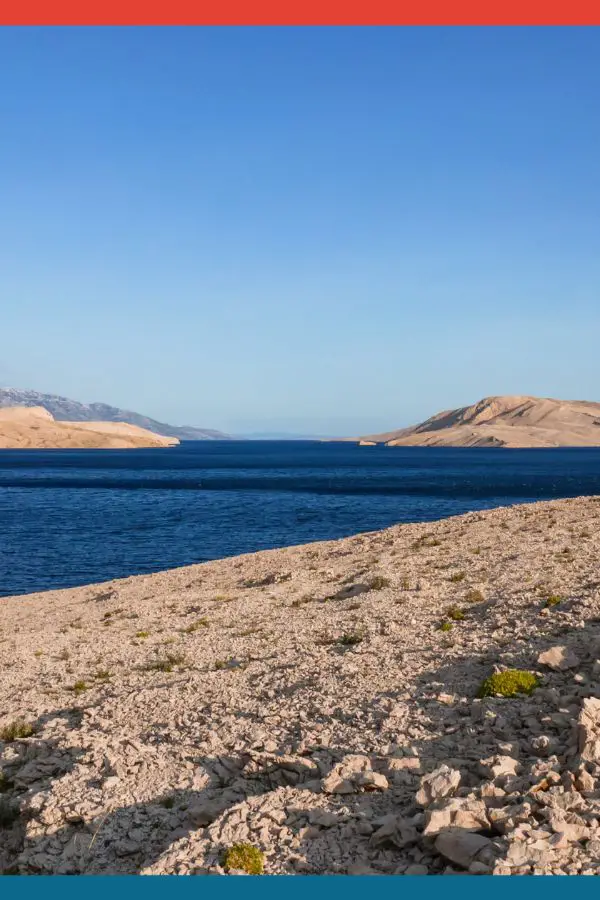
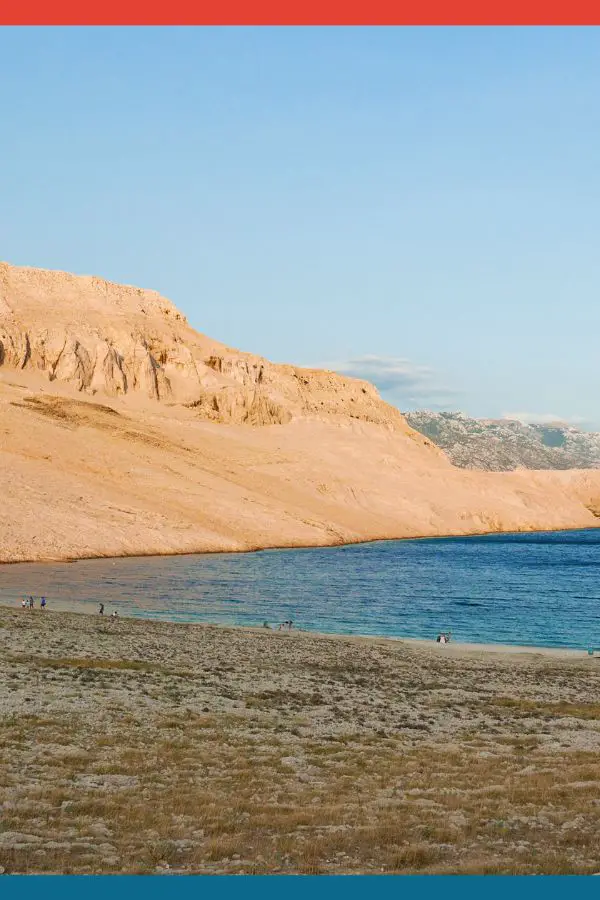
Located 30 miles from the city of Nurata, in the north west of Uzbekistan, is the crystal blue water of Lake Aydarkul. Formed when the Syr Darya River burst its banks in the flood of 1969, the lake is 3000 sqm and a haven to countless species of fish, birds and plant life. A strong Uzbekistan tourist attraction, visitors flock here to enjoy the many activities and spend long days lost in the natural surroundings.
The rich flora and fauna that cover the banks of the “sea amid sand” are home to hundreds of species of wildlife and birds. Come with your binoculars and cameras, and spot pelicans, eagles and vultures. Visit in Spring or Summer to catch the alpine grasslands changing colours, with bright red tulips and snowy-white acacia.
Substitute the camera for a fishing rod and spend a day angling for a catch in the spectacular lake. Carp, bream, perch and catfish will tease you, as a pleasant day is spent bobbing around on the lake. Seasons are April-May and August-September.
Away from the lake, discover the rugged and winding mountain passes surrounding the Lake on foot, or by horseback or camel. View the ancient rock paintings gallery in the Sarmysh Gorge, showcasing more than 3,000 petroglyphs from the Stone and Bronze ages. Or choose to do nothing, and relax taking in the spectacular views and serene silence.
Getting to Aydarkul: By road, approx 3 hours from Samarkand or Bukhara, passing through deserts and mountains with fascinating views.
Top attraction to visit: Aydarkul Lake
Map Of The Things To Do In Uzbekistan
To help you plan your trip to Uzbekistan, find all the top 9 places to visit in Uzbekistan on the map below.
We hope you enjoyed this list of the top 9 tourist attractions in Uzbekistan. Looking for more inspiration and planning tips in Uzbekistan? Find all our guides here.

